Rejoindre l’équipe
Equipe LIME
Offre de stage M2 / thèse : Optomechanical coherence in a single live cell
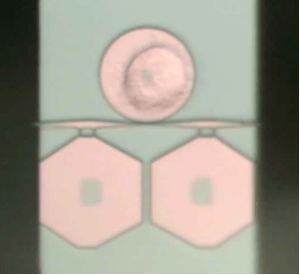
This internship/PhD thesis aims to explore these questions at the level of a single live cell, using the tools of quantum optomechanics, which enable unprecedented sensitivity and time-resolution [1]. In the last years, our team carried the first optomechanical experiments on biological objects, albeit in a dry environment where the biological functions were turned off [2,3]. More recently, we immersed optomechanical experiments in a physiological liquid medium in order to measure a living object in action, when biological mechanisms are this time turned on. The image shows an individual live cell deposited on the surface of an optomechanical disk (radius 11 μm) fabricated in our clean-room. The disk is evanescently coupled to a nanophotonic waveguide hold by two hexagonal pads, enabling real-time time optomechanical measurement of the cell. Building on this approach, the project will investigate active biological mechanisms in the cell and link them to the capacity to sustain or degrade the coherence of mechanical and optical degrees of freedom, hence exploring a practical interface betweem quantum science and biophysics.
Methods and techniques: Quantum optics, nanomechanics, biophysics, coherence
References:
[1] I. Favero and K. Karrai, Nat. Phot. 3, 201 (2009).
[2] E. Gil-Santos et al, Nature Nanotechnology 15 (6), 469-474 (2020).
[3] O. Alvar, et al. IEEE 36th International Conference on Micro Electro Mechanical Systems (MEMS 2023).
Contact: Ivan Favero
Offre de stage M2 / thèse (financée) : Intrication quantique d'oscillateurs mécaniques
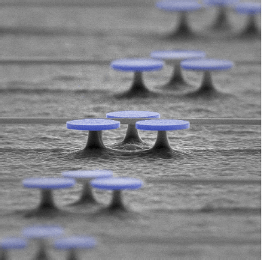
Similarly to a single atom, the motion of a massive, mesoscopic-scale mechanical resonator can behave quantum mechanically when cooled down to ultra-low temperatures. The study of quantum states of motion of such system has both fundamental and practical interests: as a test of quantum mechanics in systems beyond the few-particle ensembles, and its interplay with gravitation; or as a light-matter interface for the development of quantum communication networks, for storing and transducing quantum information.
A mechanical resonator, such as the micrometer-sized disks fabricated in our team (picture below), also confines optical modes that strongly interact with the motion. Therefore, light provides a means to shape the quantum state of motion of such an object when prepared close to its ground state (the ‘phonon vacuum’), by adding or removing phonons one by one. Ligth also probes the obtained states.
This internship/PhD thesis aims to realize multipartite quantum control, entanglement and superposition, in systems composed of several of these optomechanical resonators, either evanescently coupled or arranged in an interferometric configuration. This work will target in particular the generation of maximally-entangled GHZ states, of importance in quantum computing protocols, or N00N states, of interest for sensing with sub-standard quantum limit sensitivity, and offering the possibility to explore the concept of nonlocal influence in quantum mechanics.
Methods and techniques: Quantum optics, nanomechanics, single-photon counting, low temperatures
References:
I. Favero and K. Karrai, Nat. Phot. 3, 201 (2009),
M. Aspelmeyer, T. Kippenberg and F. Marquardt, Rev. Mod. Phys. 86, 1391 (2014)
S. Barzanjeh, Nat. Phys. 10, 1038 (2021)
A. Barbero, S. Pautrel, …, A. Borne, I. Favero (2025).
Contacts: Adrien Borne, Ivan Favero
Offre de post-doctorat : Etats quantiques du mouvement d'un résonateur mécanique

Left: scanning electron microscope image of an optomechanical disk resonator mechanically shielded from the environment (nanofabrication by our team). Right: theoretical Wigner function of a superposition Fock state.
The motion of massive, mesoscopic-scale mechanical resonators can behave quantum mechanically when cooled down to ultra-low temperatures. The exploration of such systems in the quantum regime has interests ranging from fundamental testing of quantum mechanics in mesoscopic massive objects to their use as quantum sensors, or in quantum networks, e.g. for transducing or storing the quantum information.
This project aims at shaping arbitrary target quantum states of motion [1] of an optomechanical resonator such as the microdisk pictured on the right and developed in our group. The mechanical quantum information can be encoded in the device through its interaction with light [2], and then characterized through optical tomographic reconstruction [3]. This work will also consider increasing the dimensionality by including several optomechanical resonators, thereby involving entanglement between massive objects.
Methods and techniques: Quantum optomechanics, single-photon counting, quantum state tomography, cryogenics
References:
[1] MR Vanner, M Aspelmeyer and MS Kim, PRL 110, 010504 (2013).
[2] I Favero and K Karrai, Nat. Phot. 3, 201 (2009). M Aspelmeyer, T Kippenberg and F Marquardt, Rev. Mod. Phys. 86, 1391 (2014).
[3] MR Vanner, I Pikovski, and MS Kim, Ann. Phys. 527 (2015).
Contact : Adrien Borne
Offre de thèse (financée), offre de postdoctorat : Interface quantique mécanique entre micro-ondes et optique
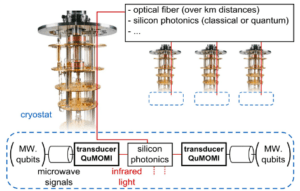
Transducers in a quantum information network, linking microwave qubits nodes and silicon photonics
Le développement des technologies de l’information quantique nécessite d’interconnecter différents systèmes quantiques ayant des taches spécifiques (calcul, mémoire), comme les plateformes de qubits micro-ondes. Les photons dans le proche infra-rouge permettent un tel transfert efficace de l’information quantique, en préservant l’état non classique sur de longues distances. La conversion de l’information quantique entre photons micro-ondes et photons optiques est donc une étape clef que ce projet vise à réaliser.
L’objectif de ce projet est donc de concevoir un dispositif permettant de démontrer la conversion de signaux classiques puis quantiques entre ces deux domaines spectraux. Ce convertisseur sur puce sera constitué d’un résonateur supraconducteur micro-onde et d’un résonateur optique, tous deux en interaction avec un mode mécanique qui sera le médiateur de la conversion. Avec ces convertisseurs, nous viserons ensuite la génération d’intrication entre qubits microondes distants.
Ce projet sera mené en étroite collaboration avec nos partenaires à Grenoble : l’Institut Néel expert en circuits quantiques supraconducteurs et électromécanique, et le CEA Leti l’un des principaux organismes de recherche technologique en Europe.
Méthodes et techniques : optomécanique, interconnexion quantique, simulations numériques, nanofabrication, basses températures.
Contacts : Ivan Favero, Adrien Borne
À lire aussi
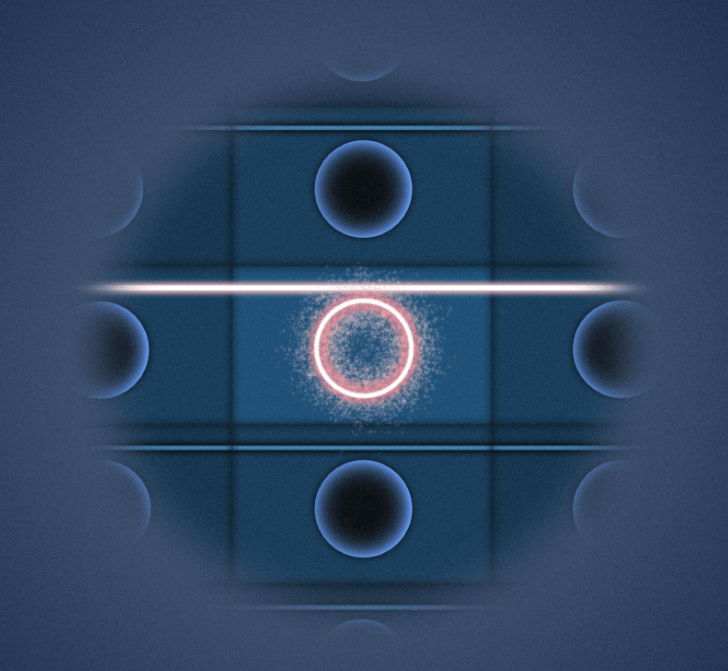
TUPHO, pour la production à grande échelle de circuits photoniques intégrés
Le projet TUPHO est une initiative qui veut combler le fossé entre innovation en amont et production à grande échelle dans l’industrie des circuits photoniques intégrés (PICs). Il est porté par Hamidreza Neshasteh et Ivan Favero, membres de l’équipe Light and...
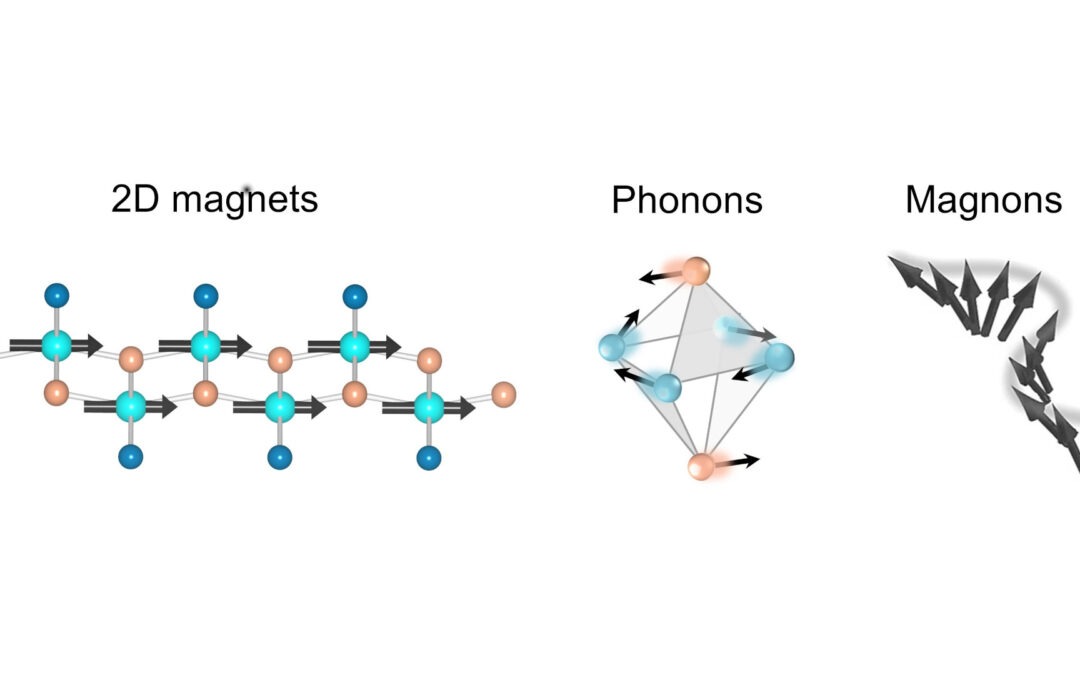
Towards light control of van der Waals magnets
Laboratoire: MPQ (Matériaux et Phénomènes Quantiques), Université Paris Cité & CNRS Adress: Bâtiment Condorcet – 10 Rue A. Domon et L. Duquet – 75013 Paris Internship/PhD supervisor: Niloufar Nilforoushan and Yann Gallais Tel: 0157276223 e-mail:...

Résonance ferromagnétique sur puce pour les hétérostructures de van der Waals : anisotropie et amortissement du cobalt interfacé avec des matériaux 2D exfoliés
Une collaboration entre le pôle technique, la plateforme de la salle blanche et le groupe TELEM du laboratoire MPQ a permis de développer une nouvelle expérience démontrant que la résonance ferromagnétique large bande standard reste un outil efficace pour sonder la...

Science des matériaux – Quand la surface impacte en profondeur…
Les surfaces cristallines présentent souvent des reconstructions1, supposées n’affecter que quelques couches sous la surface. Une étude collaborative (laboratoire Matériaux et Phénomènes Quantiques à Paris, Institut P’ à Poitiers, et ligne de lumière SixS) a analysé...
